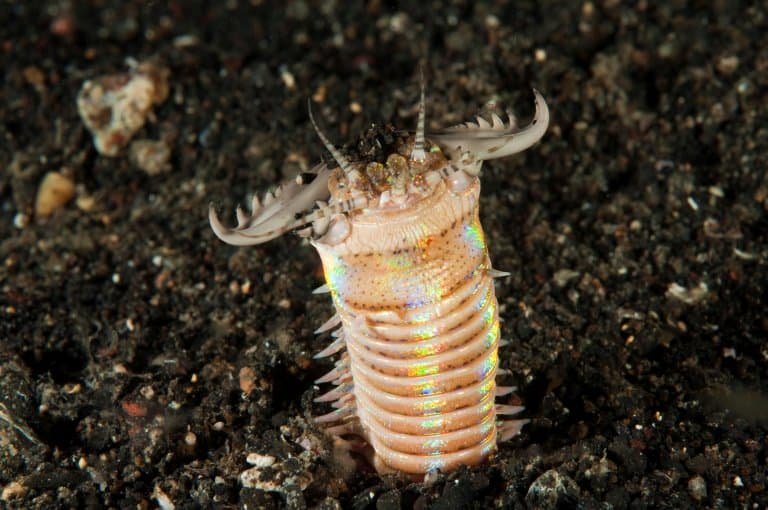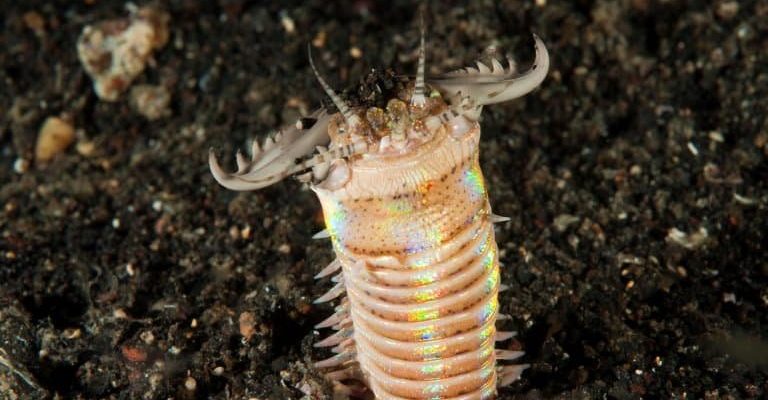
To answer that, it’s essential to dive into what makes bobbit worms unique and how they interact with their environment. Let’s explore the world of these intriguing beings and see if they really do have a bite that’s worse than their bark.
What Exactly Are Bobbit Worms?
Bobbit worms, scientifically known as *Eunice aphroditois*, are segmented marine polychaete worms found in warm, shallow waters across the globe. Think of them as the hidden ninjas of the sea floor. They can grow up to 10 feet long, and their vibrant colors can range from green to red, making them a bit of an eye candy in the ocean.
These worms are usually buried in the sand or mud with just their head exposed, waiting patiently for unsuspecting prey to swim by. When the chances are right, they strike with impressive speed, using their sharp, jaw-like appendages. But here’s the kicker: their hunting method raises a lot of questions about whether they possess toxins, venom, or anything dangerous at all.
Understanding Venom vs. Toxins
Before we get into whether bobbit worms are toxic or venomous, it’s crucial to understand the difference between the two. Venom is a type of toxin that an animal injects into another creature through bites or stings. Think of snakes or spiders; they deliver venom to subdue their prey or defend themselves.
On the other hand, toxins can be harmful substances that can affect other organisms, but not necessarily through injection. For example, some plants or fungi produce toxins that can cause illness if ingested.
So, where do bobbit worms fit into this picture?
Do Bobbit Worms Have Venom?
Here’s the thing: bobbit worms do not have venom. When they catch their prey, they use their speedy jaws to latch onto it rather than injecting venom. Their hunting technique is more about physical prowess than chemical warfare.
This means that if a human were to get bitten by a bobbit worm, it wouldn’t feel like a snake bite. The main concern is injury from their sharp jaws! They might take a chunk out of your skin, but they don’t cause systemic poisoning like a venomous creature would.
Are Bobbit Worms Toxic?
Now, you might be wondering if bobbit worms are toxic in any way. The short answer is, no, they don’t produce harmful toxins. However, their diet consists of various small fish and crustaceans, which could be toxic if they’ve ingested marine plants or animals that contain toxins.
In simpler terms, if a bobbit worm eats something toxic, and you eat that worm, there could be a risk involved. But for the most part, these worms are safe to be around. Just remember not to poke or prod them!
The Bobbit Worm’s Hunting Strategy
What’s fascinating about bobbit worms is their hunting strategy. They’re ambush predators, which means they rely on stealth and speed rather than toxins. When a fish or crustacean comes close, the bobbit worm bursts out of its hiding spot with a remarkable speed to capture its prey. It’s like watching a slow-motion video of a lion pouncing on its target!
Their sharp jaws clamp down quickly, securing their meal. Once they have a grip, they’ll pull their victim back into their burrow. This sudden burst of energy is what makes them effective hunters, rather than relying on venom.
Potential Risks of Bobbit Worms
While bobbit worms are not venomous or toxic, it’s essential to approach them with caution. Their bite can be quite painful due to their strong jaws. Imagine stepping on a Lego—painful, right? Now think of that pain multiplied if those sharp jaws took a bite out of your skin.
For divers and ocean enthusiasts, it’s crucial to keep your distance. The last thing you want is a nasty bite from this colorful creature. Here are some tips to stay safe:
- Observe from a distance.
- Avoid touching them.
- Be aware of your surroundings when snorkeling or diving.
Why Bobbit Worms Matter in the Ecosystem
Even though bobbit worms might sound scary, they play a vital role in the marine ecosystem. As predators, they help control the population of smaller fish and crustaceans, ensuring a balanced habitat. They also serve as a food source for larger marine animals, contributing to the food chain.
By maintaining this balance, they help keep the reef systems healthy and vibrant. So, even though they don’t pack a venomous punch, their existence has a significant impact on underwater life.
Concluding Thoughts on Bobbit Worms
In summary, bobbit worms are incredible creatures that captivate both scientists and ocean lovers. They do not produce venom or toxins, relying instead on their impressive hunting skills. Their sharp jaws can cause pain if provoked, but they’re not dangerous in the traditional sense.
Next time you’re diving or reading up on marine life, you can appreciate bobbit worms for their unique role in the ocean’s ecosystem without worrying about a nasty bite. They might be unusual, but they certainly contribute to the beauty and complexity of marine life. So, keep exploring, stay curious, and remember to respect these fascinating underwater creatures!

